| Liberation 1944:
The British, Part One
By Mike Bennighof, Ph.D.
October 2024
 The British Army probably played a bigger part in winning the Second World War than any force other than the Red Army of Workers and Peasants. British troops fought in France in 1940, and then the Allies stormed ashore in 1944, the Brits were in the lead again. The British Army probably played a bigger part in winning the Second World War than any force other than the Red Army of Workers and Peasants. British troops fought in France in 1940, and then the Allies stormed ashore in 1944, the Brits were in the lead again.
Their exploits are the focus of Panzer Grenadier: Liberation 1944. The British Army is well-supported by tanks and “funnies,” along with its hard-fighting infantry. It’s a full sheet of Brits, our wonderful die-cut and silky-smooth pieces so finely cut without the monstrous force of traditional die-cutting that we have to put a stripe on the back so you can tell the difference.
Let’s take a look at what they bring to the table:
Infantry
 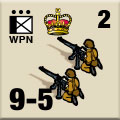  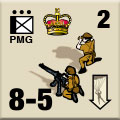
The poor, bloody infantry is much better than the numbers suggest: a British rifle platoon has 36 men, supported by a 2-inch mortar at the platoon level and three Bren light machine guns, one for each squad. The riflemen carried the Lee Enfield .303 caliber bolt-action rifle or sometimes the newer Number Four variant; each squad leader had a Sten submachine gun though a number of riflemen seem to have acquired this weapon as well. The 2-inch mortar was a fairly useless weapon when used as intended, but some mortarmen discovered that it could be fired horizontally from the hip without always breaking the firer’s bones, producing a massive short-range shotgun-like blast.
A British rifle company had four platoons rather than the three common to most other armies, and was commanded by a Major rather than a Captain. That fourth rifle platoon took the place of the machine-gun (or heavy weapons) platoon that usually made up a company’s fourth platoon in other armies.
That means that while a German infantry battalion at full strength has nine infantry platoons, a British one has 12 with a total firepower of 60 as opposed to 54 for the Germans.
British practice concentrated machine guns at the division level; after doing away with the practice for a while, in February 1944 the British Army re-instituted the divisional machine-gun battalion. The new battalion had 36 Vickers machine guns in three companies of thee platoons each (four weapons per platoon) plus a company of heavy 4.2-inch mortars. The machine gun platoons would be parceled out to the rifle battalions as needed; this allowed concentration of firepower for situations known to division command, but often left the line battalions weak in unexpected crises.
Britain came rather late to the paratrooper game, but jumped in whole-heartedly following German successes during the invasion of France and the Low Countries in 1940. Volunteers joined newly-formed battalions of the new Parachute Regiment, while standing infantry battalions were converted to the parachute role. By the time of the Normandy invasion the British Army had two full airborne divisions plus a separate parachute brigade, and the British Indian Army had its own parachute brigade as well.
A Para battalion more closely resembled the infantry battalions of other armies than it did a British rifle battalion. The Para battalion had three rifle companies of three platoons each, plus two large mortar platoons with four 3-inch mortars each and an anti-tank platoon armed not with anti-tank guns but with the spring-loaded PIAT.
That was the paper organization. In practice, things worked out somewhat differently. The battalion was issued with “reserve” weapons: four Vickers machine guns, which the battalion commander could use to replace the four tubes of one of the mortar platoons. And for the riflemen, the battalion received 300 Sten guns. Most battalion commanders appear to have handed out all of the extra weapons, plus as many more as they could scrounge: the Sten guns and the PIATs to the rifle squads, while the anti-tank platoon became a machine-gun platoon instead or, in some cases, an assault platoon.
Getting the Vickers guns into action was deemed crucial, since the airborne divisions had no machine gun battalion on which they could draw for such support. The Paras seem to have had no shortage of automatic weapons, however, hinting that all of the reserve weapons plus many more were in the field.
Tanks
  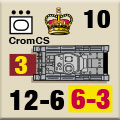 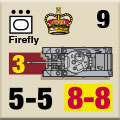
When the British landed in Normandy, they brought tanks with them. Many tanks. The backbone of most British armoured (with a “u”) divisions was the American-made M4 Sherman. Tough and reliable, the Sherman was far superior to most British-made tanks. Unfortunately for its crews, which soon christened it the “Tommy Cooker” or “Ronson” (after a popular cigarette lighter of the day), it was markedly inferior to the standard German medium tank, the PzKpfw IV, and had a tendency to burst into flames.
The British did turn the Sherman into one of the most effective tank-killing machines of the war, fitting their deadly 17-pounder to a modified turret to create the “Firefly.” The Firefly could knock out any German tank, but since it was based on the Sherman, could in turn be knocked out by just about any German tank. Fireflies did not usually operate in platoon (“troop” in British Army parlance) strength but rather were doled out one per Sherman platoon. In Panzer Grenadier terms that would either dilute their effect or make all the Sherman pieces far too powerful. So we’ve shown the Firefly as its own platoon – the British player just doesn’t get very many of them, in the same proportions as they operated historically.
The British get a large number of their own crapulent medium tank, the Cromwell, operated mostly by 7th Armoured Division in this campaign. It’s a hair faster than the Sherman and has less capability against soft targets, but has the same problem confronting much more capable German tanks. The designers compromised with a 6-pounder main gun re-bored to fire the same 75mm round as the Sherman; that allowed them to place this weapon in the same mounting as a 6-pounder. While it did fire a heftier high-explosive round than the 6-pounder, it was much less capable as an anti-tank weapon.
  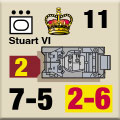 
British doctrine still divided tanks between “cruiser” types like the Cromwell and slower, heavily-armored “infantry” tanks intended to, curiously enough, support the infantry. The type’s represented in Liberation 1944 by the Churchill Mark VII; the number revealing the many failed models that preceded it. The Mark VII carried the same re-bored 75mm 6-pounder as the Cromwell, and waddled along quite slowly, but had very thick armor.
Along with cruiser tanks and infantry tanks, the British Army also fielded a handful of light tanks. The Stuart VI (British designation of the American-built M5) by this point in the war was used only for reconnaissance, where its speed could be of some use. The 37mm gun, useless against German armor, did come with a very good canister round.
The Tetrarch, intended as an airborne tank, is just as fast and even weaker, with less capability against both armored and soft targets. Thankfully for the British side, it only appears in a few scenarios.
And that wraps the first half of our look at British forces in Liberation 1944; in the next we’ll look at their specialized armor, support weapons and fearsome close-support aircraft.
You can order Liberation 1944 right here.
Sign up for our newsletter right here. Your info will never be sold or transferred; we'll just use it to update you on new games and new offers.
Mike Bennighof is president of Avalanche Press and holds a doctorate in history from Emory University. A Fulbright Scholar and NASA Journalist in Space finalist, he has published a great many books, games and articles on historical subjects; people are saying that some of them are actually good.
He lives in Birmingham, Alabama with his wife, three children, and new puppy. He misses his lizard-hunting Iron Dog, Leopold.
Daily Content includes no AI-generated content or third-party ads. We work hard to keep it that way, and that’s a lot of work. You can help us keep things that way with your gift through this link right here.
|
